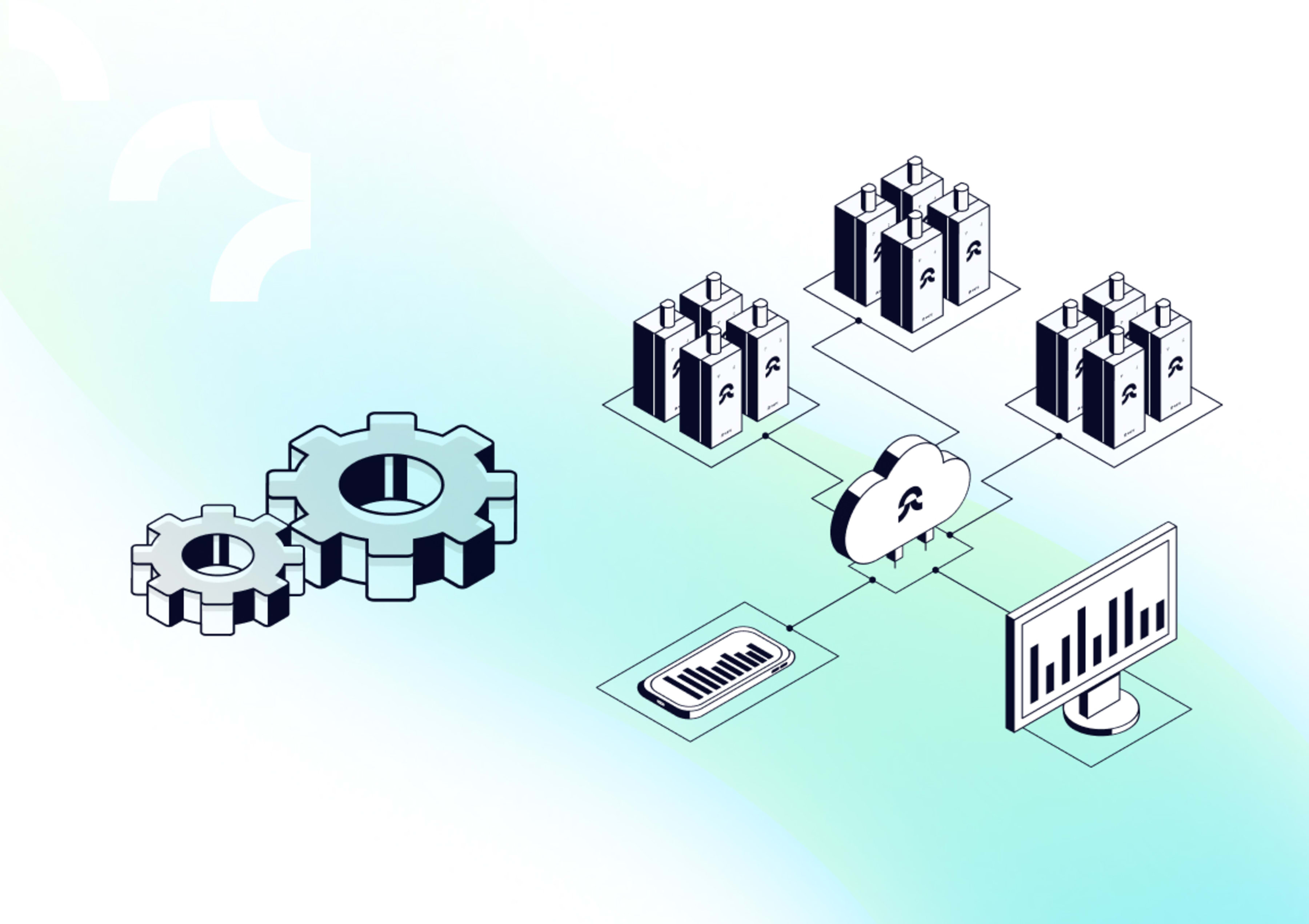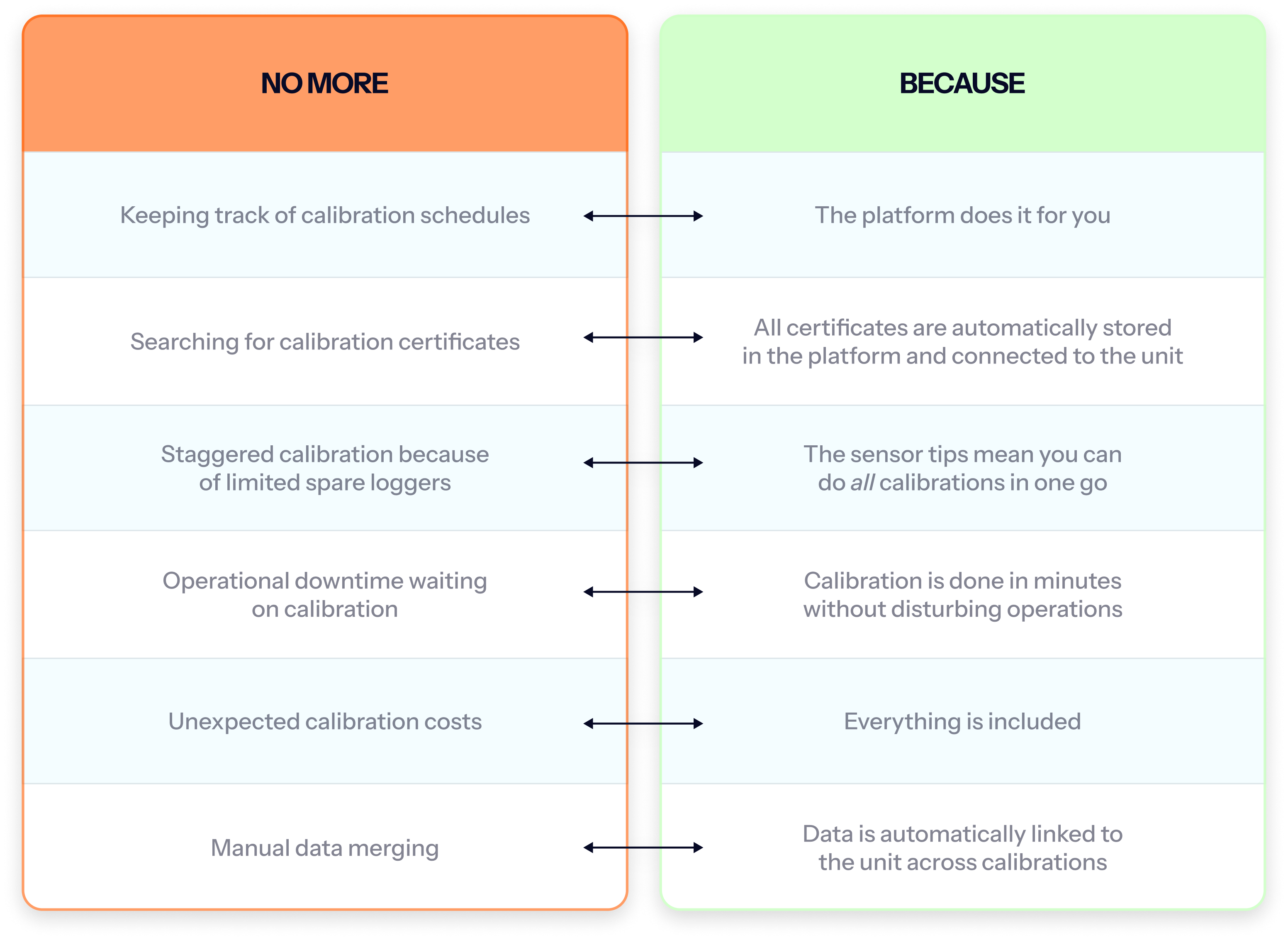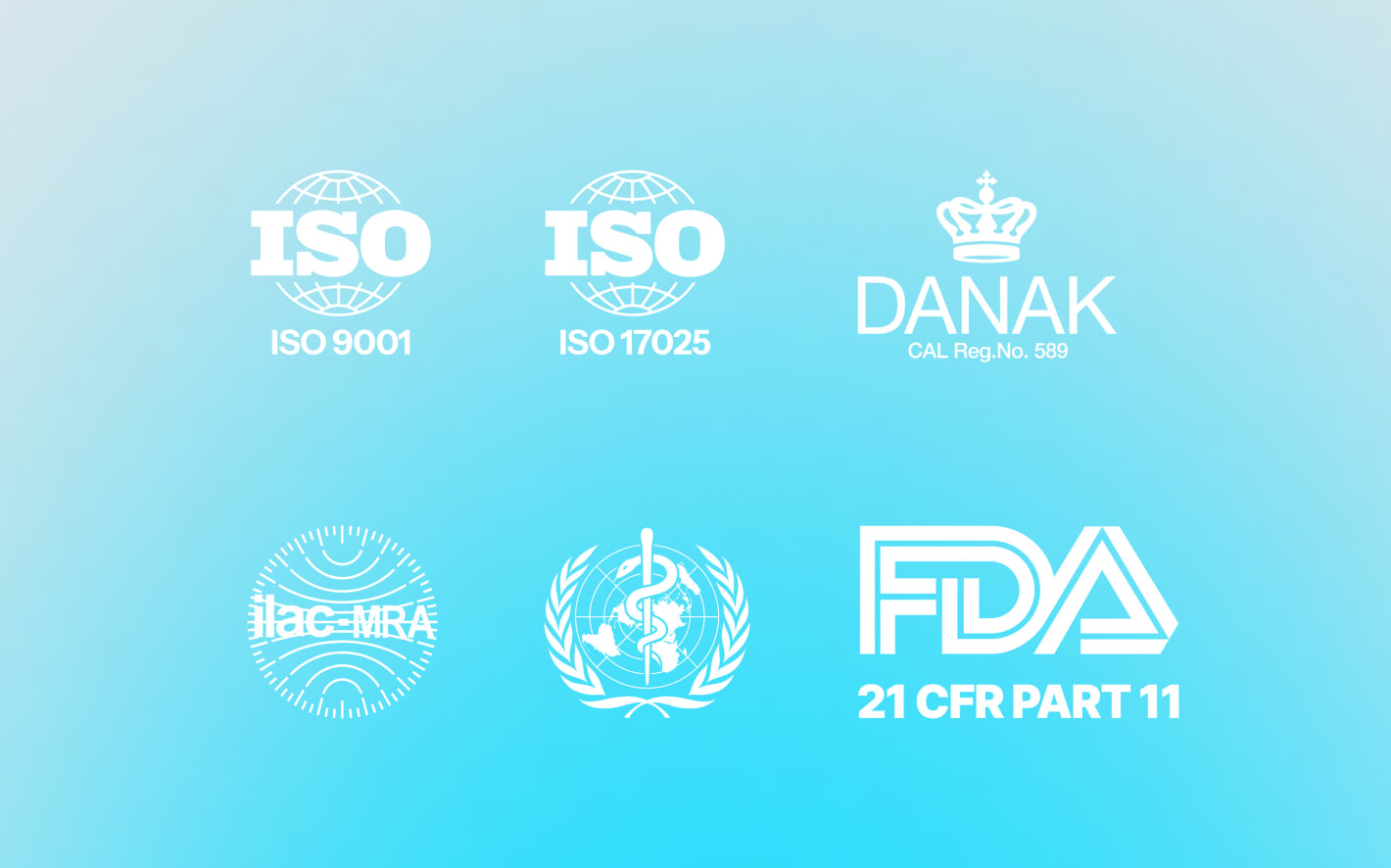Connect your monitoring system to your FMS or BMS
Add wireless temperature monitoring to your FMS/BMS without rewiring.
With Eupry’s temperature monitoring and compliance solution you can add a wireless “agility layer” to your traditional Facility Monitoring Systems (FMS) and Building Management Systems (BMS) in regulated pharma, healthcare logistics, and other GxP-regulated industries.
Here is how it works.

Hardwired FMS setups slow down equipment changes and create risk
Facility Monitoring Systems (FMS) and Building Management Systems (BMS) are built for stability. They keep HVAC, clean rooms, and utilities under control. But when equipment needs to move or change – such as adding an incubator or relocating a fridge – the wired setup becomes a bottleneck.
- Rewiring delays: New I/O points and engineering work slow down operations.
- Production downtime: Every change introduces paperwork and waiting time.
- Shadow systems risk: USB data loggers and standalone alarms create parallel records that fragment data integrity and complicate audits.
Validated temperature monitoring without rewiring
How Eupry’s temperature monitoring integration fixes it
Eupry is a wireless monitoring system and compliance solution designed for GxP environments.
By adding a wireless monitoring layer that works in conjunction with your existing FMS or BMS, you get validated temperature and environmental monitoring without rewiring, with full 21 CFR Part 11 and Annex 11 controls, ISO 17025-accredited calibration, and API-based integration into your existing systems.
Your wired backbone stays in place for stability. Eupry provides the agility for equipment that moves, changes, or is frequently added.

How the solution works
Wireless Wi-Fi data loggers: Small, battery-powered devices that attach to your equipment (fridges, freezers, incubators, stability chambers, etc.). They automatically stream temperature, humidity, and CO2 data to the cloud platform through your Wi-Fi network. Learn more about the wireless data loggers.
Swappable sensor tips: External sensors click onto the logger. You can use different sensor types depending on your needs – standard temperature sensors for refrigerators, ultra-low-temperature probes for -90°C freezers, humidity sensors for warehouses, or CO2 sensors for incubators.
Cloud monitoring platform: Web-based interface where you see real-time data, manage alarms, access calibration certificates, generate audit reports, and maintain your complete compliance documentation in one place. Includes a 21 CFR Part 11 module for electronic records and signatures.
Patented quick-swap calibration: When calibration is due, you swap only the sensor tip – not the entire logger. The new ISO 17025-accredited calibration certificate automatically attaches to the device record in the platform. The logger stays in place, data continuity is maintained, and calibration takes minutes instead of hours. Learn more about the on-the-wall calibration solution.
No USB downloads: Data transfers automatically through Wi-Fi. If connectivity drops, devices buffer locally and backfill when the connection is restored.
Powerful API: Powerful, secure API linking directly into databases with access to live data, alarms, compliance data, calibration data, measurement data, trend analysis, and more.
The core benefit
You can deploy monitoring to new equipment in minutes, move loggers between locations without losing data continuity, and handle calibration without operational downtime or spare logger inventory.
How does Eupry connect to an FMS or BMS?
Eupry does not replace your FMS or BMS. It complements it through a wireless overlay and API-based data exchange.
The integration architecture
- Wireless data capture: Wi-Fi loggers attach to fridges, freezers, incubators, and other GxP equipment. They stream validated temperature and humidity data to a secure, GxP-ready cloud platform with offline buffering if connectivity drops.
- Secured REST API: Your integration layer pulls time-series data, alarm states, asset IDs (GS1 GRAI format), and audit metadata from Eupry's API. You can then push that data into your FMS, BMS, or plant historian using your existing middleware or vendor toolsets.
- No field-bus dependency: Eupry does not connect directly to field-bus protocols or hardware controllers. All integration flows through the API and standard export formats (CSV, PDF, or API pulls). This approach avoids the complexity and validation burden of controller-level integration.

Adding equipment without new I/O
One of the most common pain points: You need to add monitoring for a new incubator or fridge, but your FMS has no available I/O channels, or adding them requires purchasing hardware, scheduling engineering time, and validating the changes.
With Eupry, you attach a wireless logger in minutes, configure alarm routing through the API, and optionally display the data in your FMS dashboard. No rewiring. No I/O expansion. No multi-week project to add one device.
What is “out of the box” vs. what requires custom integration
Available out of the box:
- REST API access to monitoring data, alarms, and audit records
- CSV and PDF exports for bulk data and compliance reporting
- Continuous data capture with automatic offline buffering
- ISO/IEC 17025 accredited calibration through DANAK
- 21 CFR Part 11 module for electronic records and signatures
Delivered through scoped integration projects:
Connecting Eupry to specific FMS, BMS, or EMS platforms such as Siemens Desigo CC, Schneider EcoStruxure, Johnson Controls Metasys, or Honeywell EBI is possible but requires an integration layer where your team will work with the Eupry team to or integrator scope the data fields, alarm taxonomy, update frequency, and validation requirements per site.
API integration and alarm bridging
Most regulated pharma operations already have an integration layer or middleware platform. Eupry's REST API fits into that architecture.
How the API integration works:
- Pull structured data: Your integration layer retrieves time-series readings, alarm events, device metadata, and calibration certificates from Eupry's secured REST API.
- Map to your taxonomy: Align Eupry's asset IDs (GS1 GRAI format) and alarm severity levels to your existing FMS or BMS naming conventions and escalation rules.
- Push to target systems: Feed Eupry data into your FMS, EMS, plant historian (such as AVEVA PI or OSIsoft PI), or BI platform using your integration hub.
- Start small, scale gradually: Begin with a limited set of critical equipment tags. Expand once naming conventions and alarm routing are validated and stable.

Alarm routing for unified visibility
Route deviations to your service desk: Eupry alarms can trigger notifications in your enterprise alarm server, ITSM platform, or CMMS. You define severity levels, escalation rules, and ownership assignment to match your site's procedures.
Maintain audit integrity: While facilities respond to alarms through their standard tools, the full audit trail – who acknowledged it, when, what actions were taken, and all underlying data points – remains in Eupry under Part 11 and Annex 11 controls.
Single-pane visibility: Operators see temperature deviations alongside HVAC, utility, and cleanroom alarms in their existing interface. No need to check multiple systems during incidents.
Calibration in minutes
The ISO 17025 sensor-tip approach
Traditional calibration workflows are a known pain point in pharma operations. Equipment goes offline. Technicians schedule site visits. Dry-well blocks get deployed. Manual reconciliation happens afterward. The process can take hours per sensor.
How Eupry's patented calibration mechanism works
- Swap the sensor tip, not the entire logger: The Wi-Fi logger body stays in place and continues operating. Only the temperature probe tip gets swapped with a freshly calibrated replacement.
- Automatic certificate attachment: The system links the new calibration certificate to the device record immediately. No manual entry. No reconciliation step. The audit trail shows exactly when the swap occurred and who performed it.
- Preserve trending continuity: Because the logger body and its unique GS1 GRAI ID remain constant, your year-over-year trending data stays clean. The sensor tip swap doesn't create a discontinuity in your historical dataset.
- ISO/IEC 17025 accreditation through DANAK: All calibrations are traceable to national standards through DANAK accreditation, meeting GxP and ISO 17025 requirements for measurement traceability.
This "on-the-wall" calibration approach typically reduces calibration downtime from hours to minutes, with fewer manual steps and full traceability for QA review.


Power BI and historians
Eupry provides a native pathway for feeding temperature and environmental data into Power BI for cross-site quality dashboards. The same API works with Tableau, Qlik Sense, or other BI platforms.
For larger-scale data operations, land Eupry feeds in Snowflake, Databricks, Azure Synapse, BigQuery, or Redshift. If you run AVEVA PI (formerly OSIsoft PI) or another historian platform, your integrator can backfill Eupry data alongside utility tags and HVAC data for unified trending and analysis.

Download a product catalog
Automate and bring temperature compliance into one digital solution. Get instant access to all technical specifications, solution options, and more in the catalog.
Four places connecting your monitoring to your + FMS shines
- Fill-finish and support labs (GMP): Add high-density equipment monitoring without waiting for cable runs or I/O changes.
- Packaging & QA release (GMP): Asset moves are fast; each device carries a unique GS1 GRAI ID for clean mapping and audit.
- Warehousing & 3PL (GDP): Electronic records under Annex 11 and 21 CFR Part 11 with GDP-oriented documentation and continuous mapping options.
- Distribution (GDP): Central oversight across sites and partners; five-year encrypted retention supports trending and inspections.
Some of the FMS and BMS platforms that Eupry integrates with
These platforms are widely used in pharma, biotech, and regulated logistics across the Nordics, the UK/Ireland, and the US.
For instance:
Building Management Systems (BMS)
- Siemens Desigo CC: Pharma-oriented reporting including MKT calculations and audit trail capabilities
- Schneider Electric EcoStruxure (EBO): Regulated Industries Compliance Pack for Part 11-style controls
- Johnson Controls Metasys (MVE): Validated environments features with electronic signatures
- Honeywell EBI: Annex 11 and Part 11 whitepapers with validated environment options
Facility Monitoring Systems (FMS)
- TSI FMS: Cleanroom and utility monitoring with GAMP-aligned workflows
- Lighthouse LMS Pharma: Real-time monitoring with Part 11-designed security controls
Your integrator will determine the optimal data path based on your existing architecture.
Security, quality, and device standards
- ISO/IEC 27001:2022 certified information security management
- ISO/IEC 17025 accredited calibration through DANAK
- ISO 9001 certified quality management
- 21 CFR Part 11 module for electronic records and signatures
- Annex 11 alignment for computerized system controls
- AES encryption with up to five-year retention
- Offline buffering maintains data integrity during connectivity gaps
- CE, FCC, RoHS marked Wi-Fi loggers with ~2-year battery life
- GS1 GRAI asset identity for equipment tracking
- Granted patent (August 6, 2024) for sensor-tip calibration mechanism
